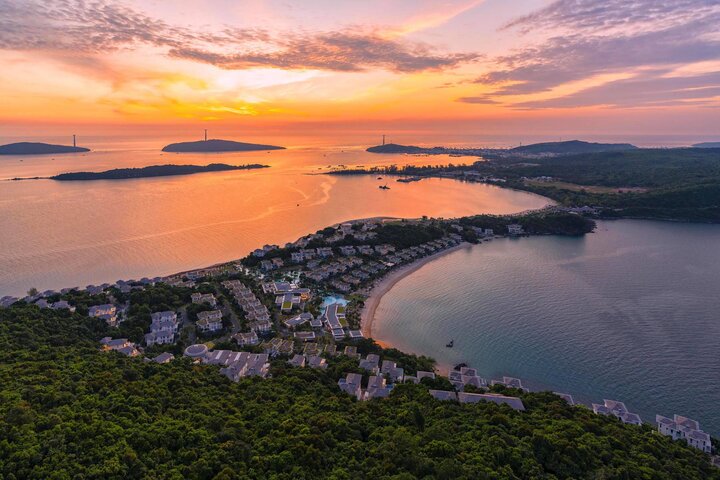1. Ong Doi Cape – Phu Quoc, Vietnam
At Phu Quoc’s southern tip, Ong Doi Cape offers a rare geography trick: two short beaches face opposite directions, so one side is usually leeward. That’s the trick—pick your calm cove and swim. The sand is fine with occasional smooth pebbles near the points; the entry is quick and shallow, ideal for relaxed dips. Geometry is the headline here: sunrise on one horizon, sunset on the other, plus a 270-degree sky that keeps light interesting all day. Premier Village Phu Quoc terraces down both flanks without crowding the waterline. For travelers who value singular settings over long promenades, Ong Doi is one of Vietnam’s most distinctive coastal addresses—and a left-field choice within the best beaches in Southeast Asia.
![]()
Dual-horizon views at Ong Doi Cape. (Photo: Collected)
2. Kem Beach – Phu Quoc, Vietnam
Kem Beach is a balanced crescent on Phu Quoc’s south coast where creamy white sand meets clear jade water. The bay is naturally sheltered, so wave energy stays low and the near-shore remains calm for relaxed swims. The sand is dry and ultra-fine, compressing softly underfoot without feeling heavy. The shoreline feels pure and uncluttered, even as high-end stays line the back beach—JW Marriott Phu Quoc Emerald Bay, New World Phu Quoc Resort, and Premier Residences Phu Quoc Emerald Bay. International lists have spotlighted Kem Beach, reflecting its rise with global travelers. What sets it apart is equilibrium: pristine scenery paired with polished hospitality, where easy, safe swims segue into unhurried hours under casuarinas. For a low-key, five-star day by the sea, Kem Beach quietly proves why Vietnam belongs in any shortlist of the best beaches in Southeast Asia.
![]()
Kem Beach – top 50 most beautiful beaches on the planet (Photo: Collected)
3. Ha Long Bay – Quang Ninh, Vietnam
A UNESCO World Heritage seascape of emerald water and limestone towers, Ha Long Bay also shelters small sandy stops—Titov and other coves often featured on day and overnight cruises. Sand is medium-grain and firm underfoot; entries are short and shallow, designed for quick, scenic dips between viewpoints. The emerald tone comes from natural plankton and fine sediment, but the surface is often mirror-still in the lee of towers. Back on shore, Sun World Ha Long Complex adds the Queen Cable Car to Ba Deo Hill, a hilltop Sun Wheel, and theme/water parks—broadening what a “bay day” can be. Heritage offshore, modern play onshore: a distinctive mix within the best beaches in Southeast Asia.
![]()
The famous world heritage site Ha Long Bay. (Photo: Collected)
4. Cat Ba Island – Hai Phong, Vietnam
Part of the UNESCO-inscribed Ha Long Bay – Cat Ba Archipelago, Cat Ba mixes accessible sands (Cat Co 1–3) with short hikes and boat trips through Lan Ha’s karst maze. Sand is fine and light-colored, the gradient modest, and the clean sandy bottom makes for easy, confidence-building entries. With headlands on both sides and a shield of islets offshore, short-period waves are typical and chop is limited, especially mornings. At lower tides the foreshore widens for easy walks along the rock base; at higher tides steps drop almost straight to the sea for quick dips. Sun World Cat Ba Cable Car shortens the mainland transfer (its record-holding pillar underlines the scale), making beach time more accessible. It’s a neat package—calm coves, karst views, quick logistics—squarely in the best beaches in Southeast Asia.
![]()
Cat Co beaches in Cat Ba. (Photo: Collected)
5. Sao Beach – Phu Quoc, Vietnam
Sao Beach runs almost seven kilometers, a bright ribbon of soft sand lapped by shallow, turquoise water. The seabed is soft and even, so you can wade far before the depth changes, with typical fair-weather waves below knee height. Facing the island’s southeast, Sao is often calmer and clearer from May to October, while the dry season brings that pale-green glow under high skies. Palms offer reliable shade; the tidal range is moderate, so walks are easy most of the day. The formula is simple and effective: arrive, settle under a palm, float in warm water, repeat. For a straightforward island day with postcard clarity, Sao Beach merits mention among the best beaches in Southeast Asia.
![]()
The pristine scenery at Sao Beach. (Photo: Collected)
6. My An Beach – Da Nang, Vietnam
Just south of My Khe, My An trades buzz for calm. The sand is fine and even, the shore slope small, and micro-shelter from buildings keeps surface chop down at common swim hours. Premier Village Danang Resort anchors this ward-fronting section with villa stays, direct beach access, and family-friendly facilities. Mornings are ideal for easy swims and shoreline walks; late afternoons cast a soft, golden light across the water without heavy crowds. If you want a quieter base that keeps Da Nang’s dining and airport within easy reach, My An is a practical, restful choice among the best beaches in Southeast Asia.
![]()
Calm water and resort-lined shore make My An an easy base. (Photo: Collected)
7. My Khe Beach – Da Nang, Vietnam
My Khe is a straight, six-kilometer sweep with a small slope, fine golden sand, and generally readable currents. The near-shore shallow zone commonly extends 20–40 meters, and the beach stays “usable” across much of the tide. Recent Travelers’ Choice lists ranked My Khe among Asia’s top beaches, underscoring its broad appeal. Add nearby Marble Mountains and quick trips to Hoi An, and you have a city-and-sea combo that’s hard to match. Clean, convenient, and consistently user-friendly, My Khe earns its place in any guide to the best beaches in Southeast Asia.
![]()
Golden sand and gentle surf minutes from downtown Da Nang. (Photo: Collected)
8. Nusa Dua – Bali, Indonesia
Sheltered on Bali’s southern tip, Nusa Dua offers a broad, clean strand and lagoon-calm shallows ideal for families and relaxed swimmers. A seaside promenade links five-star resorts, spas, cafés, and the Waterblow lookout, so you can move easily between beach time and amenities. The integrated resort zone is recognized for sustainability initiatives and tidy public spaces, reinforcing its polished reputation. Early mornings bring quiet walks and safe swims; afternoons deliver light breezes and long shade. For travelers who prize comfort, order, and an easy on-ramp to Bali’s culture and dining, Nusa Dua is a dependable pick among the best beaches in Southeast Asia.
![]()
Relaxing lagoon water at Nusa Dua. (Photo: Collected)
9. Pink Beach – Komodo, Indonesia
Pink Beach’s rose-tinted sand—created by red coral fragments mixing with white grains—meets clear water and healthy fringing reef. A few fin-kicks offshore, snorkelers find parrotfish, soft corals, and excellent visibility in fair weather. Sitting inside Komodo National Park, a UNESCO World Heritage Site, the beach benefits from conservation rules that shape visitor behavior and keep conditions photogenic. Come for the rare coloration, stay for easy reef time straight from shore. For travelers who collect unique natural palettes, Pink Beach stands out on any list of the best beaches in Southeast Asia.
![]()
Rose-tinted sand and clear water make Pink Beach unmistakable. (Photo: Collected)
10. Railay Beach – Krabi, Thailand
Accessible only by boat, Railay feels like a self-contained peninsula framed by dramatic limestone walls. West Railay and nearby Phra Nang deliver soft sand and swimmable water, while small eateries and low-rise stays keep the pace unhurried. Try a short scramble to a viewpoint, rent a kayak along the cliffs, or simply settle in for an Andaman sunset. Recent Best of the Best rankings placed Phra Nang among Asia’s top beaches, confirming the peninsula’s visual punch. For travelers who want big-screen scenery with simple pleasures, Railay belongs to the best beaches in Southeast Asia.
![]()
Limestone cliffs rise behind clear water at Railay. (Photo: Collected)
11. White Beach – Boracay, Philippines
White Beach runs for about four kilometers with talc-fine coral sand and a very gentle gradient, which creates wide, shallow, glassy water—especially in the Amihan season (roughly Nov–Apr). During Habagat (May–Oct) the wind swings onshore and chop can build, yet many segments remain swimmable thanks to the curving shoreline and offshore shelter. Color shifts from pale aqua to light cobalt through the day; mornings are usually the clearest. Tidal range is modest, so the beach stays usable for long stretches. Palm shade is easy to find, and the seabed is soft and forgiving underfoot. Taken together—ultra-fine sand, broad shallow zones, and a bay shape that tempers wind—White Beach is a benchmark for the best beaches in Southeast Asia.
![]()
Powdery sand and calm, shallow water stretch along White Beach. (Photo: Collected)
12. Perhentian Islands – Terengganu, Malaysia
Split between Besar and Kecil, the Perhentians specialize in clear shallows and coral gardens just meters from the sand. Expect easy snorkeling with parrotfish and clownfish, and turtle sightings in calm weather; on land, short jungle paths stitch coves and viewpoints together. Evenings stay quiet—waves and stars set the rhythm rather than parties. International lists have long celebrated the archipelago’s near-shore reefs, keeping it high on snorkelers’ maps. For accessible underwater color without boats, this duo fits naturally among the best beaches in Southeast Asia.
![]()
Clear shallows and near-shore coral make the Perhentians ideal for snorkeling. (Photo: Collected)
13. Maya Bay – Phi Phi Islands, Thailand
Maya Bay’s amphitheater of pale sand and 100-meter cliffs became iconic—then reset under a restoration-first model after a 2018 closure. Today, seasonal rules cap daily entries and prevent direct boat landings to protect corals and seagrass. The experience is calmer and clearer: arrive early for soft light, then pair the stop with neighboring coves to ease pressure on the bay. While it’s a managed visit rather than a long beach day, Maya Bay remains a powerful reminder that sustainability belongs at the heart of the best beaches in Southeast Asia.
![]()
Turquoise water enclosed by sheer limestone walls at Maya Bay. (Photo: Collected)
14. Ngapali Beach – Rakhine, Myanmar
Ngapali traces seven kilometers of pale sand under palms, punctuated by fishing boats and village life. Mornings bring gentle, clear water for easy swims; afternoons suit leisurely bike rides and seafood lunches at family kitchens. Development remains discreet, so the strand feels open even in peak months. Earlier Travelers’ Choice accolades named Ngapali a top Asian beach; what keeps people returning is the same slow, spacious rhythm. For an unhurried coastal reset, Ngapali still earns a quiet spot among the best beaches in Southeast Asia.
![]()
Palm-lined sand and calm swells shape easy days at Ngapali. (Photo: Collected)
Conclusion
Whether you want reef time from the sand, UNESCO-listed seascapes, or polished resort zones with promenade ease, these reordered picks show why the region owns the phrase best beaches in Southeast Asia—clean water, usable sand, and the right pace for your day.



